Imagine a busy storefront. Customers come and go, and security is paramount. That’s where rolling shutter doors come in, providing a vital layer of protection. But have you ever wondered how these robust barriers are actually made? The answer lies in a specialized machine: the rolling shutter slat forming machine.
Components of a Rolling Shutter Slat Forming Machine
This industrial marvel is a symphony of coordinated parts, each playing a crucial role in shaping the metal into the slats that form the rolling shutter door. Here’s a breakdown of the key components:
- Decoiler: This is the starting point, where the metal coil, typically galvanized steel or pre-painted steel, is unwound and fed into the machine.
- Roll Forming Stations: The heart of the machine, these stations consist of a series of precisely shaped rollers. As the metal sheet passes through each station, the rollers progressively bend and shape it into the desired profile for the slat. The number of stations determines the complexity of the final slat design.
- Punching Unit (Optional): For specific slat designs, a punching unit can be integrated. This unit incorporates punches and dies that perforate holes or create specific shapes in the slat, enhancing security or ventilation.
- Cutting Unit: Once formed, the slats need to be cut to length. There are two main cutting options: hydraulic and fly-saw. Hydraulic cutters offer a clean and precise cut, while fly-saw cutters provide a faster cutting speed.
- Runout Table: The finished slats are conveyed away from the machine on a runout table, ready for stacking or further processing.
- Control System: The brain of the operation, a PLC (Programmable Logic Controller) controls the entire process. It manages motor speeds, ensures precise positioning of the rollers, and coordinates the cutting operation.
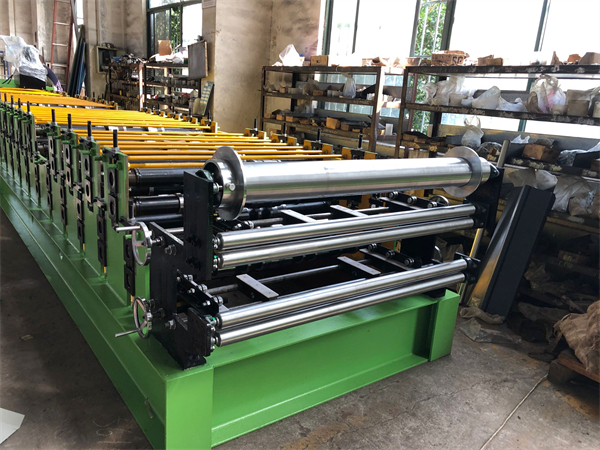
Industrial Applications of Rolling Shutter Slat Forming Machines
Rolling shutter doors offer a multitude of benefits, making them a popular choice across various industries. Here are some key application areas:
- Security: In warehouses, factories, and retail stores, rolling shutters provide a robust barrier to deter break-ins and vandalism.
- Climate Control: Rolling shutters can help insulate a space, reducing energy costs for heating and cooling.
- Light Control: They can be used to block out sunlight in warehouses or create blackout conditions for photography studios.
- Noise Reduction: Solid rolling shutters can dampen noise transmission, creating a quieter work environment for factories or sound stages.
- Hurricane Protection: In coastal regions, rolling shutters can add an extra layer of defense against high winds and flying debris during hurricanes.
Choosing the Right Rolling Shutter Slat Forming Machine
Selecting the ideal machine depends on several factors:
- Production Volume: High-volume production facilities will require a robust machine capable of continuous operation.
- Slat Design Complexity: More intricate slat designs necessitate a machine with more roll forming stations and potentially a punching unit.
- Material Thickness: The machine’s capacity should match the thickness of the metal coil you plan to use.
- Budget: Rolling shutter slat forming machines range in price depending on their capabilities and automation level.
-
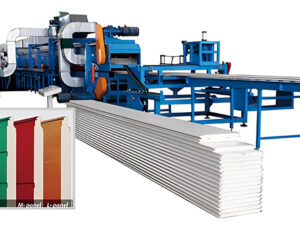 गेराज दरवाजा पैनल रोल बनाने की मशीन
गेराज दरवाजा पैनल रोल बनाने की मशीन -
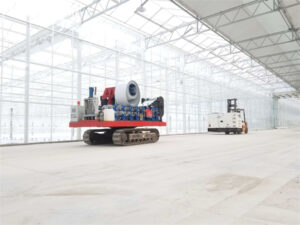 टैंक श्रृंखला के साथ ग्रीन आधुनिक कृषि गटर पैनल रोल बनाने की मशीन
टैंक श्रृंखला के साथ ग्रीन आधुनिक कृषि गटर पैनल रोल बनाने की मशीन -
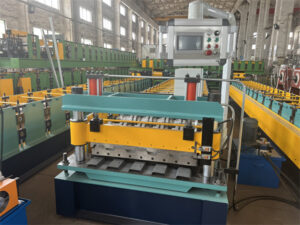 स्वचालित रूप से PPGI बाड़ पैनल के लिए रोल बनाने की मशीन चीन
स्वचालित रूप से PPGI बाड़ पैनल के लिए रोल बनाने की मशीन चीन -
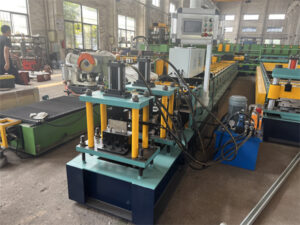 बाड़ गाइड रेल के लिए रोल बनाने की मशीन कंपनी
बाड़ गाइड रेल के लिए रोल बनाने की मशीन कंपनी -
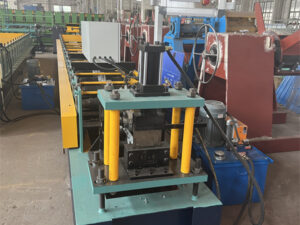 बाड़ पोस्ट गाइड रेल अच्छी कीमत के लिए रोल बनाने की मशीन की लागत
बाड़ पोस्ट गाइड रेल अच्छी कीमत के लिए रोल बनाने की मशीन की लागत -
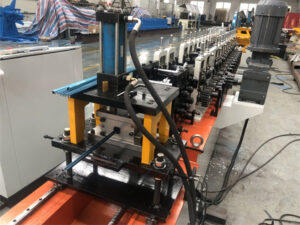 ग्लास विंडो सपोर्टर मशीन के लिए स्टेनलेस यू चैनल
ग्लास विंडो सपोर्टर मशीन के लिए स्टेनलेस यू चैनल -
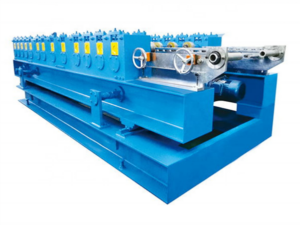 शटर बॉक्स सीरीज बनाने की मशीन
शटर बॉक्स सीरीज बनाने की मशीन -
 शामियाना ट्यूब रोल बनाने की मशीन
शामियाना ट्यूब रोल बनाने की मशीन -
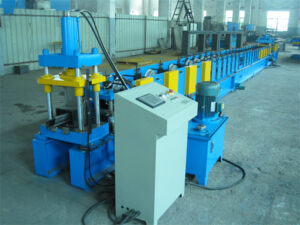 धातु दरवाजा फ्रेम रोल बनाने की मशीन डबल छूट
धातु दरवाजा फ्रेम रोल बनाने की मशीन डबल छूट
Advanced Features and Considerations
While the core components remain the same, some advanced features can enhance the machine’s functionality and efficiency:
- Automatic Stacking System: This feature automatically stacks the finished slats, saving labor and ensuring organized storage.
- Variable Speed Control: The ability to adjust the production speed allows for flexibility based on demand.
- Remote Monitoring: Advanced machines can be monitored and controlled remotely for increased efficiency.
रखरखाव युक्तियाँ Rolling Shutter Slat Forming Machine
- Regular Cleaning: Regularly clean the rollers and other components to prevent metal buildup and ensure smooth operation.
- Proper Lubrication: Lubricate the machine according to the manufacturer’s recommendations to minimize friction and wear.
- Preventative Maintenance: Schedule regular preventative maintenance to identify and address potential issues before they escalate into bigger problems.
The Future of Rolling Shutter Slat Forming Machines
As technology advances, we can expect to see rolling shutter slat forming machines become even more sophisticated. Here are some potential trends:
- Increased Automation: Machines with higher levels of automation will streamline production and reduce labor costs.
- Advanced Roll Forming Techniques: New roll forming techniques may allow for the creation of even more complex and lightweight slat designs.
- Integration with Industry 4.0: Machines may become more interconnected, allowing for real-time data collection and optimization of the production process.

सामान्य प्रश्न
What is a Rolling Shutter Slat Forming Machine?
A rolling shutter slat forming machine is a metalworking tool used to manufacture the slats (individual strips) that make up a rolling shutter door. It works by continuously feeding a coil of metal strip through a series of precisely shaped rollers that bend and form the metal into the desired profile for the rolling shutter slats.
How Does it Work?
The metal strip is fed through the machine, where each set of rollers progressively bends and shapes the material. These rollers are designed to create specific folds and profiles in the metal, ultimately forming the interlocking mechanism and structural shape of the rolling shutter slat.
What are the Different Types of Rolling Shutter Slat Forming Machines?
There are two main types of rolling shutter slat forming machines:
- Gearbox type: This is a more robust machine suitable for thicker metal gauges (up to 1.25mm) due to its higher torque transmission capability.
- Chain type: This is a lighter-duty machine typically used for thinner metal gauges and offers a quieter operation.
What are some factors to consider when choosing a Rolling Shutter Slat Forming Machine?
- Material thickness and type: The machine needs to be compatible with the gauge and type of metal you plan to use (e.g., galvanized steel, pre-painted steel).
- Desired slat profile: Different slat profiles exist for various purposes (e.g., security, insulation). Ensure the machine can produce the profile you need.
- Production speed: Consider how many slats you need to produce per unit time.
- Level of automation: Some machines offer features like automatic punching for holes or cut-outs in the slats.
What are the benefits of using a Rolling Shutter Slat Forming Machine?
- Production efficiency: The machine allows for large-scale, continuous production of rolling shutter slats.
- Consistency: The machine ensures consistent quality and dimensions in the produced slats.
- Customization: With different rollers and tooling, the machine can be adapted to produce various slat profiles.
